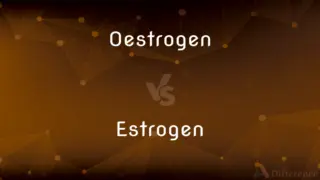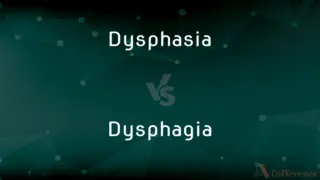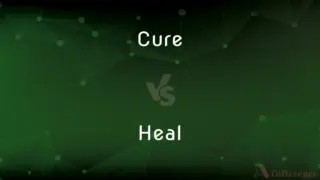Albinism vs. Vitiligo — What's the Difference?
Edited by Tayyaba Rehman — By Maham Liaqat — Updated on March 26, 2024
Albinism is a genetic condition causing lack of pigment from birth, while vitiligo involves progressive pigment loss, appearing as patches.
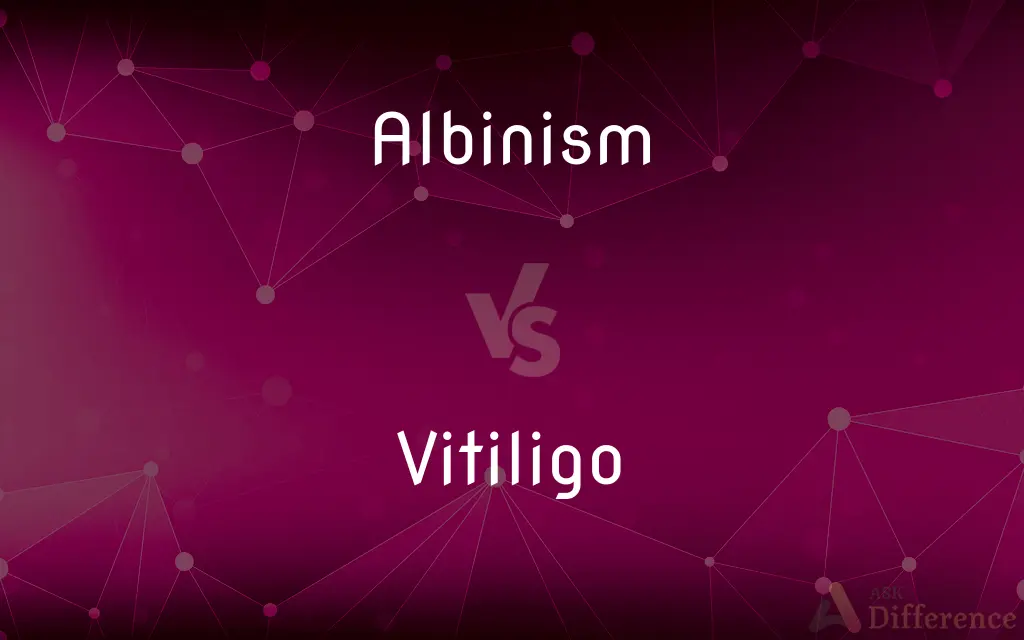
Difference Between Albinism and Vitiligo
Table of Contents
ADVERTISEMENT
Key Differences
Albinism is characterized by a genetic inability to produce melanin, the pigment that colors the skin, hair, and eyes. Individuals with albinism are born with this condition and have a uniformly pale appearance that remains consistent throughout life. Vitiligo, on the other hand, is an autoimmune condition that results in the loss of skin pigment in patches. This loss can occur at any stage of life and may progress, stabilize, or even reverse in some cases.
The cause of albinism is a mutation in one of several genes involved in the production of melanin. This mutation is inherited from the parents and affects melanocytes, the cells responsible for pigment production. Conversely, vitiligo is thought to occur when the immune system mistakenly attacks and destroys melanocytes in certain areas of the skin, leading to uneven pigmentation.
While albinism affects the entire body, including the skin, hair, and eyes, leading to visual problems and sensitivity to sunlight, vitiligo generally affects the skin in specific areas. People with vitiligo may have normal hair color and eye color, and their condition primarily impacts their skin appearance.
Management and treatment options differ significantly between the two conditions. For albinism, management focuses on protecting the skin and eyes from sun damage due to the lack of melanin. For vitiligo, treatment options include topical steroids, phototherapy, and, in some cases, surgery to even out the skin tone or stop the spread of pigment loss.
Both albinism and vitiligo have profound impacts on individuals, not just physically but also psychologically and socially, due to the visible differences in appearance they cause. However, awareness and understanding of these conditions have improved, leading to better support and acceptance for those affected.
ADVERTISEMENT
Comparison Chart
Nature
Genetic condition
Autoimmune condition
Onset
Present from birth
Can occur at any age
Pigment Loss
Complete lack of melanin
Progressive loss in patches
Affected Areas
Entire body (skin, hair, eyes)
Skin, primarily in patches
Treatment
Sun protection, visual aids
Topical steroids, phototherapy, surgery
Compare with Definitions
Albinism
Uniformly pale appearance.
Due to their condition, people with albinism exhibit a uniformly pale skin and hair color from birth.
Vitiligo
Progressive pigment loss.
Vitiligo causes the progressive loss of skin pigment in patches, which may spread over time.
Albinism
Inherited condition.
Albinism is passed down through families due to mutations in genes related to melanin production.
Vitiligo
Variable effects.
The extent and pattern of pigment loss in vitiligo can vary greatly from person to person.
Albinism
Genetic lack of melanin.
Individuals with albinism have skin, hair, and eyes with little to no pigment due to a genetic mutation.
Vitiligo
Treatment options vary.
Treatments for vitiligo aim to restore skin color or even out skin tone, including creams and light therapy.
Albinism
Sun sensitivity.
Lack of melanin makes individuals with albinism highly sensitive to sunlight, necessitating protective measures.
Vitiligo
Autoimmune origin.
Vitiligo is believed to be an autoimmune disorder where the body's immune system attacks melanocytes.
Albinism
Visual problems common.
Albinism often results in vision issues, including sensitivity to light and reduced visual acuity.
Vitiligo
Psychological impact.
The appearance of white patches can significantly affect self-esteem and social interactions for those with vitiligo.
Albinism
Albinism is the congenital absence of any pigmentation or colouration in an animal, plant, or person, resulting in white hair, feathers, scales and skin and pink eyes in mammals, birds, reptiles, amphibians and fish and invertebrates as well. Varied use and interpretation of the terms mean that written reports of albinistic animals can be difficult to verify.
Vitiligo
Vitiligo is a long-term skin condition characterized by patches of the skin losing their pigment. The patches of skin affected become white and usually have sharp margins.
Albinism
Any of several inherited conditions characterized by the reduction or absence of the pigment melanin in a person or animal, resulting in lack of pigmentation in the eyes, skin, and hair. Humans with albinism usually have vision problems.
Vitiligo
A condition in which the pigment is lost from areas of the skin, causing whitish patches, often with no clear cause.
Albinism
Lack of chlorophyll in a plant or plant part, resulting in a pale color.
Vitiligo
Partial or total loss of skin pigmentation, often occurring in patches.
Albinism
Congenital lack of melanin pigmentation in the skin, eyes, and hair or feathers (or more rarely only in the eyes); the condition of being albino.
Vitiligo
(dermatology) The patchy loss of skin pigmentation.
Albinism
The state or condition of being an albino: abinoism; leucopathy.
Vitiligo
(obsolete) Alphos, a form of leprosy.
Albinism
The congenital absence of pigmentation in the eyes and skin and hair
Vitiligo
A rare skin disease consisting in the development of smooth, milk-white spots upon various parts of the body.
Vitiligo
An acquired skin disease characterized by patches of unpigmented skin (often surrounded by a heavily pigmented border)
Common Curiosities
Is vitiligo contagious?
No, vitiligo is not contagious. It is an autoimmune condition that affects individuals differently.
What is albinism?
Albinism is a genetic condition characterized by a complete or partial lack of melanin pigment in the skin, hair, and eyes.
What treatments are available for vitiligo?
Treatments for vitiligo may include topical medications, phototherapy, and, in some cases, surgical options to restore skin color or even out skin tone.
Are albinism and vitiligo related?
While both affect skin pigmentation, albinism and vitiligo are distinct conditions with different causes and patterns of pigmentation loss.
Is albinism common?
Albinism is relatively rare, affecting approximately 1 in 18,000 to 20,000 people in the United States.
How does vitiligo progress?
The progression of vitiligo is unpredictable; patches may spread, remain stable, or in rare cases, repigment over time.
What causes vitiligo?
Vitiligo is thought to be an autoimmune condition where the body's immune system attacks the melanocytes, leading to loss of pigment in patches.
How is albinism inherited?
Albinism is inherited in an autosomal recessive pattern, meaning both parents must carry a gene for it to be passed on to their child.
Does vitiligo affect all races?
Yes, vitiligo can affect individuals of any race, though it may be more noticeable in people with darker skin.
Can albinism be cured?
There is no cure for albinism; treatment focuses on managing symptoms, especially protecting the skin and eyes from sun exposure.
Do people with albinism have normal vision?
Many individuals with albinism have vision problems, such as sensitivity to light, reduced sharpness, and involuntary eye movements.
Can vitiligo appear later in life?
Yes, vitiligo can start at any age and is characterized by the appearance of white patches on the skin that may spread.
What psychological effects can these conditions have?
Both conditions can lead to challenges with self-esteem and social interactions due to their visible differences, highlighting the importance of support and understanding.
Can lifestyle changes help manage vitiligo?
While lifestyle changes cannot cure vitiligo, protecting the skin from the sun and avoiding triggers that may worsen the condition are recommended.
Can albinism affect animals?
Yes, albinism can occur in many species, including mammals, birds, and reptiles, leading to a lack of pigment in the affected animals.
Share Your Discovery

Previous Comparison
Viss vs. Gm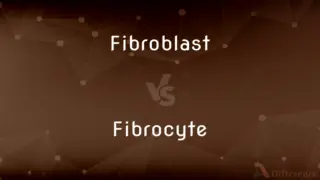
Next Comparison
Fibroblast vs. FibrocyteAuthor Spotlight
Written by
Maham LiaqatEdited by
Tayyaba RehmanTayyaba Rehman is a distinguished writer, currently serving as a primary contributor to askdifference.com. As a researcher in semantics and etymology, Tayyaba's passion for the complexity of languages and their distinctions has found a perfect home on the platform. Tayyaba delves into the intricacies of language, distinguishing between commonly confused words and phrases, thereby providing clarity for readers worldwide.






